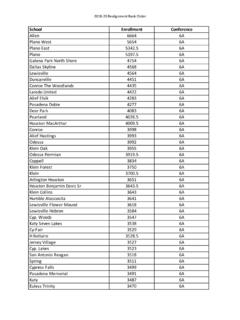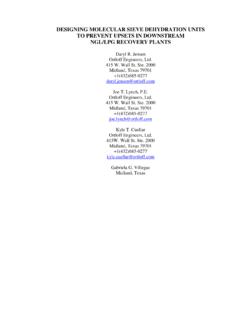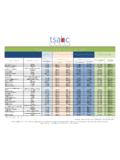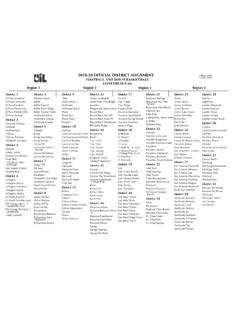Transcription of Why Do PVC CPVC Pipes Occasionally Fail?
1 Why Do PVC & cpvc Pipes Occasionally fail ? By Dr. Duane Priddy, Plastic Failure Labs, Midland, MI Preface PVC and cpvc Pipes and fittings are excellent products and have been used successfully for decades. There is a low failure rate and the use of PVC/ cpvc materials offer significant advantages over metal piping materials including ease of installation and very low failure rates. I am not aware of any health cautions regarding the usage of PVC/ cpvc Pipes and fittings other than the need to install them properly without using incompatible materials during the installation. However, as with all plumbing products including metal piping, Occasionally a pipe or fitting may fail . When a failure does occur, our experience indicates that most often the failure can be linked to improper installation practices.
2 The intent of this article is to provide assistance regarding installation errors to avoid and thereby reduce the occurrence of a failure in PVC and cpvc plumbing. Again, let me emphasize that by teaching about the main causes of occasional failure of PVC and cpvc Pipes and fittings, I am in no way suggesting that these plumbing products are less reliable or more prone to failure than any other plumbing material. Further, I am outraged by the misuse of my teachings by some to attack PVC and cpvc plumbing products as being inherently unsafe. If I were to build a home for my own family, I would use as much plastic plumbing in my home as possible to keep the costs to a minimum while providing my family with a safe living environment.
3 Most of the Main Causes of cpvc /PVC pipe Failure Listed Below are Discussed in this Article I. Improper System Engineering/Installation A. Inadequate provision for linear thermal expansion B. Excess use of Cement C. Insufficient amount of Cement D. Wrong Clamps used or Clamps too tight E. Incompatible fire caulk used F. Contact of outside of pipe with incompatible material ( , solder flux) II. Improper Operation A. Exposure to freezing temperatures without freeze protection B. Over pressurization C. Pulsating water pressure D. Use of incompatible materials around Pipes III. Contamination A. Internal 1. Use of contaminated antifreeze 2. Contaminants from metal water supply piping; , antimicrobial (MIC inhibitor) linings, corrosion inhibitors, phthalate plasticizers from pump seals/gaskets, refrigeration system lubricants B.
4 External 1. Incompatible Fire Caulk 2. Use of incompatible (black Proset) grommets to seal pipe against hole in concrete 3. Contact with incompatible plastic coated wires 4. Exposure to hot solder flux 5. Exposure to hot polyurethane foam insulation IV. Manufacturing defects A. Dirty extrusion die B. Incomplete resin consolidation C. High stresses in pipe wall due to rapid cooling V. Resin Defects A. Occlusions, char particles, voids B. Filler/pigment not well distributed IV. Abuse by Distributor A. Store in sun B. Damage during transport Introduction PVC and cpvc Pipes are one of the most extensively used plastic piping materials. The main reason for the great success of these Pipes is their low cost, extremely low failure rate, and relative ease of installation.
5 However, as with all piping materials, there are occasional failures. Occasional failures may be caused by a number of factors however improper installation is generally the most common cause when PVC and cpvc Pipes fail . Plastic Failure Labs is an independent forensic laboratory. We have been conducting forensic failure analyses of plastic parts for several years. We have carried out hundreds of forensic failure analysis investigations of cpvc and PVC Pipes and fittings at the request of insurance companies, installers, pipe manufacturers, general contractors, condominium associations, and private owners. We have found that the overwhelming/most common cause of failure is improper installation practices. Sometimes installation errors result in contamination, although these two issues are not always related.
6 The combination of Pipes under stress plus the exposure to incompatible materials, can lead to environmental stress cracking failure or ESC. This is especially the case with cpvc sprinkler system piping if not adequately flushed as recommended in NFPA 13 to remove debris and trace chemicals. If cpvc fire sprinkler systems are not flushed, trace chemicals remain trapped inside for periods of time and may become absorbed into the cpvc . cpvc is a very ductile material. However, the combination of prolonged high stress and absorption of certain hydrocarbon contaminants may cause it to weaken and develop stress cracks (Figure 1). The most common causes of occasional failure of PVC and cpvc Pipes and fittings are listed in Table 1. Also included in the table are common techniques that are used to detect the listed causes.
7 There are many tools available to the forensic scientist but the most commonly used tools are optical microscopy, scanning electron microscopy (SEM), Fourier transform infrared spectroscopy (FT IR), and gas chromatography mass spectroscopy (GC MS). Page 2 of 16 Figure 1. Formation of a stress crack on the inside of a cpvc fire sprinkler pipe at a point where a tight . fitting clamp was used. Table 1. Six main causes of occasional pipe failure and testing methods generally used for diagnoses: Type of Failure Root Cause of Failure Tests Improper installation excessive cement sectioning & inspection insufficient cement sectioning & inspection wrong clamp used site inspection clamps too far apart site inspection clamps too tight out of round/clamp marks no allowance for thermal expansion site inspection Pipes not properly aligned site inspection short insertion sectioning & inspection pipe end not deburred sectioning & inspection pipe end not chamfered sectioning & inspection non square pipe cuts sectioning & inspection wrong antifreeze used* FTIR Contamination Incompatible thread sealants FTIR/GC MS Chemical Compatibility Incompatible thread cutting oils FTIR Phthalates from gaskets/seals GC MS Incompatible MIC
8 Inhibitor FTIR/ESI MS/GC MS Incompatible antifreeze* GC MS/FTIR Product defects pipe dimensions wrong resin not fully consolidated SEM weak extrusion knit lines dirty die creating extrusion lines black light voids or particulates OM/SEM/EDS residual stress due to rapid cooling OM Page 3 of 16 Resin defects resin MW too low MI filler content wrong TGA additives/pigments dispersion SEM/EDS chlorine content wrong** EA Improper operation water hammer OM/SEM over pressurization OM/SEM area contamination GC MS/IR freezing OM Abuse by distributor store in sun IR damage during handling/transport OM *unique to fire sprinkler Pipes **unique to cpvc Key: OM=optical microscopy; IR=infrared microscopy; GC-MS=gas chromatography-mass spectroscopy.
9 SEM/EDS=scanning electron microscopy/electron dispersive spectroscopy; EA=elemental analysis; DSC=differential scanning calorimetry; TGA=thermal gravimetric analysis Improper Installation Excessive cement use: An installation problem that we Occasionally see is the use of excessive cement. The solvents in the cement themselves are readily absorbed into cpvc and PVC; , they readily are absorbed into the wall of the pipe and inside fitting socket resulting in solvation/softening of the material. Figure 2 shows a short piece of pipe with a fitting on each end having excess cement puddled inside the short piece of pipe . The solvents in the cement absorbed into the pipe wall resulting in softening of the pipe wall to the point that the pipe wall became swollen/softened and no longer had sufficient strength to hold water pressure resulting in blowout.
10 Figure 2. Puddling of excess cement inside of fitting ran into adjacent pipe resulting in softening and blowout of the pipe wall. Page 4 of 16 However, absorption of the solvents in the cement into the top layer of plastic in the pipe and fitting socket is necessary to achieve good bonding. The organic solvents in cement soften the surface of the pipe and fitting socket allowing the polymer molecules to intertwine to form a permanent bond. The organic solvents in the cement are volatile and quickly evaporate so that they are only around long enough to do their intended job but not long enough to cause the pipe to weaken. The problem is that Occasionally installers utilize too much cement resulting in dribbles running down the inside of vertical runs of pipe .
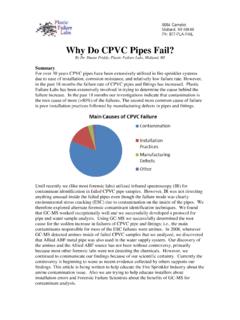

![Home [www.sa-trackandsignal.net]](/cache/preview/a/f/6/9/4/e/b/b/thumb-af694ebb53633aa11c7e5e477c8c4ca0.jpg)
